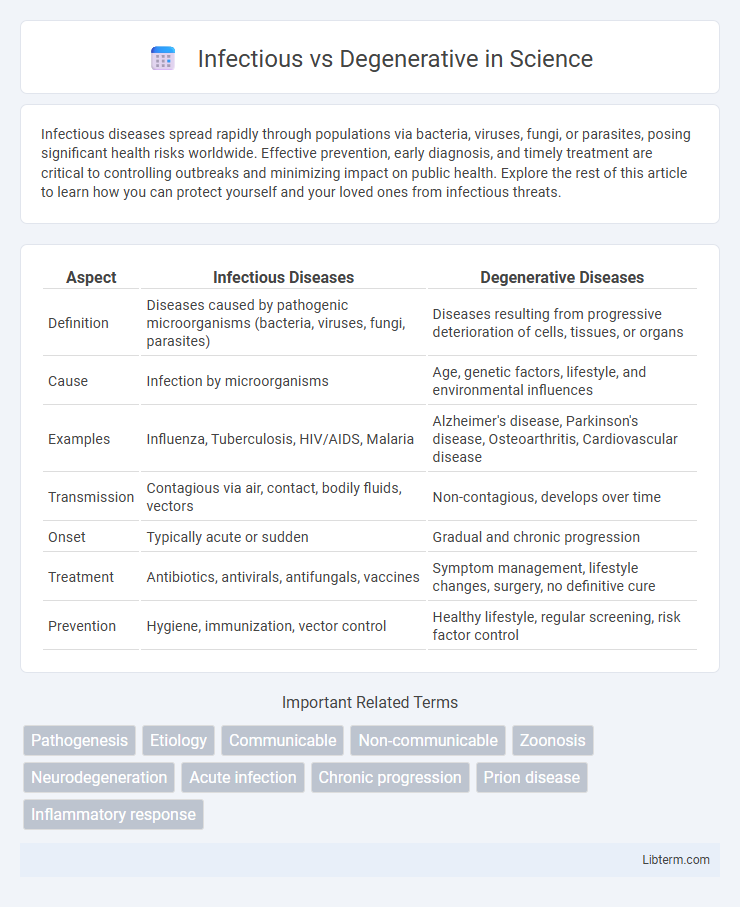Infectious diseases spread rapidly through populations via bacteria, viruses, fungi, or parasites, posing significant health risks worldwide. Effective prevention, early diagnosis, and timely treatment are critical to controlling outbreaks and minimizing impact on public health. Explore the rest of this article to learn how you can protect yourself and your loved ones from infectious threats.
Table of Comparison
| Aspect | Infectious Diseases | Degenerative Diseases |
|---|---|---|
| Definition | Diseases caused by pathogenic microorganisms (bacteria, viruses, fungi, parasites) | Diseases resulting from progressive deterioration of cells, tissues, or organs |
| Cause | Infection by microorganisms | Age, genetic factors, lifestyle, and environmental influences |
| Examples | Influenza, Tuberculosis, HIV/AIDS, Malaria | Alzheimer's disease, Parkinson's disease, Osteoarthritis, Cardiovascular disease |
| Transmission | Contagious via air, contact, bodily fluids, vectors | Non-contagious, develops over time |
| Onset | Typically acute or sudden | Gradual and chronic progression |
| Treatment | Antibiotics, antivirals, antifungals, vaccines | Symptom management, lifestyle changes, surgery, no definitive cure |
| Prevention | Hygiene, immunization, vector control | Healthy lifestyle, regular screening, risk factor control |
Introduction to Infectious and Degenerative Diseases
Infectious diseases are caused by pathogenic microorganisms such as bacteria, viruses, fungi, or parasites, leading to conditions like tuberculosis, influenza, and malaria. Degenerative diseases, including Alzheimer's, osteoarthritis, and Parkinson's disease, result from progressive deterioration of tissues or organs, often linked to aging or genetic factors. Understanding the distinct etiologies and progression patterns of infectious versus degenerative diseases is crucial for effective diagnosis, treatment, and prevention strategies.
Defining Infectious Diseases
Infectious diseases are caused by pathogenic microorganisms such as bacteria, viruses, fungi, or parasites that invade the body, leading to symptoms and illness. These diseases are often transmissible between individuals through direct contact, airborne particles, contaminated food or water, and vectors like mosquitoes. Understanding the mechanisms of infection and transmission is crucial for effective prevention and treatment strategies.
Understanding Degenerative Diseases
Degenerative diseases, characterized by progressive deterioration of cells and tissues, often result from aging, genetic factors, or lifestyle influences rather than infectious agents. Unlike infectious diseases caused by pathogens, degenerative conditions such as Alzheimer's, Parkinson's, and osteoarthritis involve chronic damage and gradual loss of function in specific organs or systems. Understanding the molecular mechanisms and risk factors behind degenerative diseases is crucial for developing targeted therapies and improving patient outcomes.
Key Differences Between Infectious and Degenerative Disorders
Infectious disorders are caused by pathogens such as bacteria, viruses, fungi, or parasites, leading to acute or chronic illness through direct infection of tissues. Degenerative disorders involve the progressive deterioration of cells, tissues, or organs, primarily due to aging, genetic factors, or environmental influences without direct microbial involvement. Key differences include the etiology, with infectious diseases stemming from external agents and degenerative diseases arising from internal, non-infectious processes affecting structural and functional integrity over time.
Causes and Risk Factors
Infectious diseases are caused by pathogens such as bacteria, viruses, fungi, or parasites, often transmitted through direct contact, contaminated food, water, or vectors like mosquitoes. Degenerative diseases result from progressive deterioration of cells and tissues, primarily influenced by aging, genetic predisposition, lifestyle factors such as smoking, poor diet, and sedentary behavior. Risk factors for infectious diseases include weakened immune systems, poor sanitation, and overcrowded living conditions, while degenerative diseases are exacerbated by chronic inflammation, oxidative stress, and metabolic imbalances.
Common Examples of Infectious Diseases
Common examples of infectious diseases include influenza, tuberculosis, HIV/AIDS, and malaria, which are caused by viruses, bacteria, and parasites. These diseases spread through direct contact, airborne transmission, or vector-borne routes, leading to rapid outbreaks and epidemics. Unlike degenerative conditions such as arthritis or Alzheimer's disease, infectious diseases primarily result from external pathogens rather than progressive deterioration of body tissues.
Common Examples of Degenerative Diseases
Degenerative diseases primarily include Alzheimer's disease, Parkinson's disease, and osteoarthritis, which are characterized by the progressive deterioration of cells, tissues, or organs over time. Unlike infectious diseases caused by pathogens such as viruses or bacteria, degenerative diseases result from genetic factors, aging, or environmental influences leading to chronic and irreversible damage. These conditions significantly impact the nervous system, joints, and other vital body functions, often leading to decreased mobility and cognitive decline.
Transmission and Progression
Infectious diseases spread through pathogens such as bacteria, viruses, or fungi via direct contact, airborne particles, or bodily fluids, leading to rapid onset and variable progression depending on immune response. Degenerative diseases, including osteoarthritis and Alzheimer's, develop progressively over time due to cellular deterioration or genetic factors, without person-to-person transmission. Understanding transmission pathways is crucial for infectious disease control, whereas monitoring and managing progression is central to degenerative disease treatment.
Diagnosis and Treatment Approaches
Infectious diseases require diagnosis through laboratory tests such as cultures, PCR, or serology to identify pathogens, while degenerative conditions rely on imaging techniques like MRI or CT scans and clinical evaluations to assess tissue damage. Treatment for infectious diseases involves targeted antibiotics, antivirals, or antifungals based on the causative microorganism, whereas degenerative disorders often necessitate symptom management through physical therapy, pharmacologic agents like NSAIDs, or surgical interventions. Early and accurate diagnosis is critical in infectious diseases to prevent spread, whereas degenerative disease management focuses on slowing progression and maintaining function.
Prevention and Long-Term Management
Infectious diseases require prevention strategies including vaccination, hygiene, and antimicrobial treatments to control pathogen spread, while long-term management often involves monitoring for complications and repeated therapy. Degenerative diseases prioritize lifestyle modifications, such as diet, exercise, and avoiding risk factors like smoking, to slow progression, with management focusing on symptom control and rehabilitation. Both conditions benefit from early detection and personalized care plans to improve patient outcomes and quality of life.
Infectious Infographic

 libterm.com
libterm.com